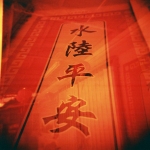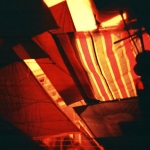Redscale photography needs a lot of light. If you’re using a SLR cam you’ll have an exposure meter plus full access to shutter speed, aperture and ISO controls. You can nearly find an infinity of combinations for the desired exposure. Piece o’ cake.
However, lomo or toy cams often do not provide as much control. My Sprocket Rocket has only two apertures and one fixed shutter speed at 1/100 s (there is also the bulb mode, but no ISO control and no exposure meter at all). That leaves only a few combinations, so it’s harder to find a good exposure… To compensate the lack of ISO control, you can set it up to the biggest aperture (even on a sunny day), and try to include a source of light at an edge of the picture (beware of flare). If it’s still too dark, switch to the bulb mode (don’t forget your pocket tripod!). It’s a bit easier with the Holga because it can open to f/8, versus f/10.8 for the Sprocket Rocket. Just practice!























